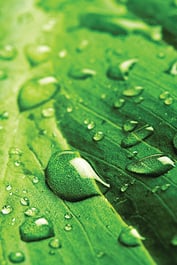 The term “spring water” brings to mind a clear, mountain stream. But “spring” or “bounce” in water actually is a safeguard for plant leaves. Liquid droplets have elasticity and bounce off of leaves. This “water bounce” protects plants because plants drink in water from their roots, not from leaves. If water lingers too long on leaves, then mold builds up and decays the plant.
The term “spring water” brings to mind a clear, mountain stream. But “spring” or “bounce” in water actually is a safeguard for plant leaves. Liquid droplets have elasticity and bounce off of leaves. This “water bounce” protects plants because plants drink in water from their roots, not from leaves. If water lingers too long on leaves, then mold builds up and decays the plant.
However, this protective “water bounce” from Mother Nature has negative side effects for farmers.
Around the world, farmers commonly spray their fields with pesticides. The innate “bounciness” of liquid droplets forces a considerable amount of the pesticide off of the plants; only a paltry amount of what is sprayed actually sticks. Therefore, farmers must use a lot more pesticide than they need. And because farmers have to use so much spray to get the desired pesticide benefits, surplus pesticide chemicals seep off plants and end up polluting land and waterways.
Researchers at MIT have come up with a technique to coerce pesticide droplets to grip to plants. This shrewd new approach uses two additives. One solution lends a negative charge, and the other solution furnishes a positive charge. The oppositely charged droplets converge on a leaf creating a water-enticing film that sticks to the surface.
By using this charged interaction technique, both additives fuse. The united additives form a hydrophilic surface on leaves, creating a water-attracting film that adheres to leaves. The hydrophilic surface also suggests that there is an enhanced likelihood of trapping future droplets on leaves, another benefit of utilizing this method.
This method does not oblige farmers to make expensive upgrades to their equipment. Minimal changes are needed to make pesticide equipment compatible with this fresh application technique. Pesticides are divided into two separate flow containers, and small quantities of the additives are inserted into each stream.
The additives are economical and are derived from everyday materials that can be supplied regionally. Farmers expend a reduced amount of chemicals to treat their crops since the pesticide sticks to plants. MIT researchers approximate that farmers will use 1/10 as much of pesticide by utilizing this new approach. Farmers slash costs and reap bigger profits margins from their crops.
Additionally, because farmers will be able to reduce the amount of chemicals they use, there is an ecological benefit. Fewer chemicals are deployed to treat crops and effects on the environment are trimmed.
This new approach can also be used for other liquid applications as well. For instance, farmers in Florida spray water to shield their crops from frost damage. Farmers can employ this technique of spraying solutions with opposite charges to use less water, thus protecting their water supplies when there is a frost danger.
Researchers are planning to complete greenhouse control tests to assess the benefits of the oppositely charged additive technique. Next, they will shift to larger farm scale field trials. The MIT scientists then expect to develop the application technique for commercialization.
Quick note about QuEChERS
QuEChERS was originally developed in 2003 for the analysis of pesticide residues in fruits and vegetables. It presents a number of advantages over more traditional techniques, including decreasing sample preparation time, fewer steps, reducing the amount of samples and chemicals needed, and delivering method transferability for a number of matrices. Teledyne Tekmar has created a new system that adds to the convenience and speed of the QuEChERs system. The AutoMate-Q40 automates two of the most popular sample preparation methods and includes innovative technology that reliably identifies liquid levels, differentiates between multiple aqueous layers within a vial and calculates their associated volumes. The system improves precision and accuracy of the sample preparation method, adds sample capacity without adding staff, reduces negative impact of lap operations on the environment and increases workplace safety. Learn more athttp://www.teledynetekmar.com/AutoMateQ40/.
